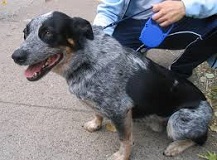The Blue Heeler appears under many names and is recognized by a handful of official institutions. You can also refer to it as the Australian Heeler, the Australian Cattle Dog, Halls Heeler, Queensland Heeler, Australischer Treibhund, or simply ACD. The institutions that recognize the breed include the North American Purebred Registry, Inc. (NAPR), the Dog Registry of America, Inc. (DRA), the Kennel Club of Great Britain (KCGB), the American Kennel Club (AKC), the Federation Cynologique Internationale (FCI), and Americas Pet Registry, Inc. (APRI).

The Blue Heeler is a herding dog that originates from Australia, originally used for driving cattle on hard terrains over long distances. This breed actually has an interesting history, being a crossing between other types of dogs and tamed dingoes. The other breeds in this famous mix include the Bull Terrier, the Dalmatian, the Australian Kelpie, and the blue dotted Collie.
Its average weight when mature is somewhere around 40 pounds, while the average height is 18-20 inches. This muscular dog is agile and powerful, it has pricked ears and a strong muzzle. The dark eyes are always alert and the neck and shoulders have a very muscular appearance. The pups are born white, but color quickly appears, as the coat becomes blue (possibly mottled or speckled, with other small markings). Their tail is long and set somewhat low.
Being a working breed, this dog is very energetic, intelligent and independent and, if you manage to structure the training in an interactive way, he will respond very well to it. When it comes to grooming and maintenance, this breed is not demanding at all. Moreover, it is considered to be one of the most intelligent dogs in the world. However, he will need a lot of exercise and must always have something to do. This is why, if your Blue Heeler is not used for work, you will have to compensate this with other rather intense activities.
When they feel at home, on their own territory, they can be very playful and loving; especially with people they already know. However, the herding instincts may kick in when strangers are around, as they can become cautious and passively aggressive. This is also why they make very good guard dogs, if they are trained for this specific task.
The Blue Heeler does not usually react well in packs of different breeds, as he can become aggressive and impulsively dominant. Nonetheless, if it grows up amongst one or two other dogs, the familiarity can easily surpass his active instincts.
Their lifespan is around 12-14 years and they are known to age well, many times keeping their senses almost intact until their last months of life. However, two of their main health problems are hereditary deafness and slowly getting blind with age.
This breed is not suited for passive apartment living, as it loves to move around. Without an active life, they can become destructive and mischievous. If you are careful at his instincts of nipping and get him a toy, he will surely have something to do for a couple of hours, if you provide enough space. All in all, if you want to own a Blue Heeler, make sure you have a spacious yard and enough energy to match his.




